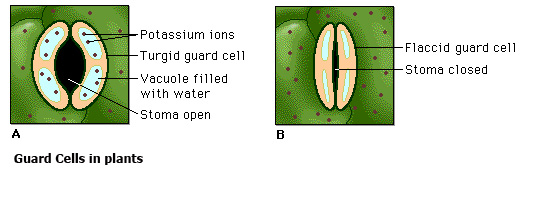This is a copy of a post in
Blue Planet Nutrients;1670768 said:As I stated earlier in this journal, misting is the best way to help regulate water loss in newly taken cuttings due to the fact that it lowers the VPD (Vapor Pressure Deficit).
I will attempt a quick lesson in basic plant physiology to try explain the and how to regulate water loss from clones (cuttings) to help prevent wilting.
I got many of these pictures off the web but didn't credit the websites I snagged them from because these are well known facts and I didn't think that citation is in order here. This is brief summary I hope you all can understand.

1) First of all, there are hundreds of stomata on the underside of each leaf. This is where CO2 enters the leaf and where water vapor is transpired (exits the plant). Guard Cells around each stomatal opening control the transpiration and gas exchange rates. K+ ions play an important role here.
Notice that in figure A the guard cells are turgid, or swollen, and the stomatal opening is large. This turgidity is caused by the accumulation of K+ (potassium ions) in the guard cells. As K+ levels increase in the guard cells, the water potential of the guard cells drops, and water enters the guard cells.
In figure B, the guard cells have lost water, which causes the cells to become flaccid and the stomatal opening to close. This may occur when the plant has lost an excessive amount of water. In addition, it generally occurs daily as light levels drop and the use of CO2 in photosynthesis decreases.
An important fact to keep in mind: The stomata open for photosynthesis. Therefore, at night, when plants are not photosynthesizing, the stomata are closed and transpiration (water loss from the leaf) is absent or very, very slow.
What is the primary driver of transpiration (Water loss from the plant)?
Than answer is Light.
What other environmental factors affect transpiration?
a. temperature
b. humidity
c. wind
d. water supply
e. leaf size and # of stomata on each leaf
A plant is like a big straw in a glass of your favorite beverage. When you suck on the straw, you create a pressure potential that is greater than what is in the glass and your favorite beverage moves into your mouth.
When a plant is photosynthesizing, water is being pulled through the plant from the Roots to the Shoots to the Leaves. The stomatal openings on the leaves are similar to the end of the straw in your mouth drinking your favorite beverage.
When the plant is not photosynthesizing (at night), the stomata are closed and there is no (or very little) water loss through the leaves therefore, the pressure potential drops significantly.
At the roots, the pressure potential is lowest, in the shoots, the pressure potential increases, at the leaves, the pressure potential is the greatest.
Again, a plant is like a big straw drinking its favorite beverage....water with Blue Planet Nutrients in it.
How can we regulate transpiration?
#1 turn the lights off - easy
#2 increase the humidity - easy as well
#3 decrease air flow around the leaf - just as easy
#4 lower temperatures - more complicated
How reducing air flow and increasing humidity will help newly taken cutting lose less water.
Water inside the leaf is liquid and inside the leaf there is 100% relative humidity.
Outside the leaf, water is in vapor form (gas).
Water turns into a gas (vapor) as the transpiration process takes place.
If the relative humidity of the air surrounding the leaf is high, then the Vapor Pressure Deficit (layer around the leaf where water transitions from liquid to gas) is lower and water loss is mitigated.
Reducing airflow and increasing humidity increases the Vapor Pressure Deficit therefore slowing down water loss.
This LINK is BADASS. Not only as it explains water loss in cuttings, it is from Texas A&M where I studied plant science. https://aggie-horticulture.tamu.edu/syllabi/326/pdf/IPPS-H2O-Talk-05-10CC.pdf
420fied, you are now armed with more tools in your tool box to perfect and hone your craft. You can now use your powers of observation to determine what works best in YOUR particular system.





